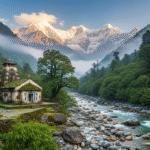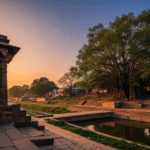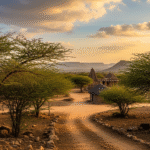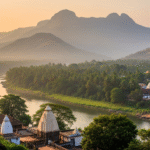Did you know the River Ganges goes over 1,560 miles across India? It serves nearly one-third of the country’s people. This ancient city, full of myth and spirituality, has many secrets. From its deep culture to the hidden rituals on its banks, Haridwar is more than a place for religious meetings. This article starts a journey to uncover less-known facts, secret rituals, and interesting tales of Haridwar. We will dive into the rich history and culture of this sacred city.
The magic of Haridwar isn’t just in its well-known places. It’s also in the hidden paths that have led believers for ages. The importance of the Kumbh Mela, in Haridwar, is now clearer thanks to archaeology. Recent findings highlight the festival’s old roots and its effects on local and global cultures.
Key Takeaways
- Haridwar’s link to the River Ganges, serving nearly a third of India’s people.
- The hidden rituals adding to Haridwar’s mystical charm.
- Secret paths that are key for pilgrims.
- The historical and cultural importance of Kumbh Mela, shown by archaeology.
- Less-known stories and legends making Haridwar uniquely captivating.
Introduction to Haridwar’s Mystical Charm
Haridwar is a city filled with divinity and timeless allure. It’s more than a place on a map; it’s a live museum filled with old traditions and devotion. Known as the gateway to the gods, it captivates many with its magical feel. This city is where the Ganges river comes down from the mountains. It keeps its charm with a mix of culture, history, and spiritual power.
The Sacred City
The sacred city of Haridwar welcomes all who are curious or devout. It is deeply spiritual and important for Hindu ceremonies. Har-Ki-Pauri, a famous ghat, is said to have Lord Vishnu’s footprints.
Haridwar hosts the Kumbh Mela, a huge religious event, every twelve years. It attracts millions for spiritual cleansing. The Ardh Kumbh happens every six years, keeping Haridwar important in India’s spiritual life. Brahmakund in Har-Ki-Pauri is very sacred for taking a dip.
An Overview
Haridwar is the start of the journey to many holy places. It mixes old temples and new buildings beautifully. The Integrated Industrial Estate (IIE) shows Haridwar’s growing industry. It covers about 2034 acres. Places like BHEL and IIT Roorkee bring a modern touch to the city. Only 10 km away, Rajaji National Park offers nature and wildlife experiences. This blend of sacred and modern draws in many people.
Haridwar’s hidden secrets and its charming essence make it a special place in India’s heart.
Haridwar’s Lesser-Known Historical Background
Haridwar sits by the sacred Ganges River. Its history is much deeper than most know. This town has rich cultural stories and old tales from past people.
Every 12 years, Haridwar hosts the Kumbh Mela. This event has happened for centuries. The Mansa Devi Temple here is very old and important spiritually.
Old havelis in Haridwar share Hindu myths. They show Haridwar’s deep link with India’s legends. The Daksha Mahadev Temple has a sad past. It is where Goddess Parvati ended her life.
In 1929, King Suchat Singh made the Daksha Mahadev Temple. It’s one of the oldest in Haridwar. The temple tells stories of the city’s religious history.
Haridwar also focuses on health and wellness. Patanjali Yog Peeth teaches Yoga by Maharishi Patanjali from 5000 years ago. It highlights Haridwar’s role in Yoga and Ayurveda.
The “Haridwar Junction” station connects to big cities. It is 220 kilometers from Delhi. Its location is very strategic.
At Rajaji National Park, you see the Shivalik ecosystem. It’s where nature and history meet.
Since 1902, Gurukul Kangri Vishwavidyalay has kept old ‘Gurukul’ education alive. This keeps Haridwar’s educational past going.
There’s more to Haridwar than its famous spots. Its hidden history helps shape a unique character over years.
| Aspect | Details |
|---|---|
| Kumbh Mela | Held every 12 years |
| Mansa Devi Temple | One of the three siddha peethas |
| Daksha Mahadev Temple | Established in 1929 |
| Patanjali Yog Peeth | Named after Maharishi Patanjali |
| Gurukul Kangri Vishwavidyalay | Traditional Gurukul system education since 1902 |
The Significance of the Ganges in Haridwar
The Ganges River, or Ganga, is very important in Haridwar. It is like the city’s heart and soul. The river flows over a large area and is worshipped as a goddess. It helps support nearly half of India’s people, including those in Haridwar.
Spiritual Importance
The spiritual significance of the Ganges in Haridwar is huge. People believe the river can remove sins. This belief brings millions to Haridwar every year. For example, the Kumbh Mela brings millions to bathe in the Ganges. Places like Har Ki Pauri are central for many holy activities.
Cultural Influence
The Ganges greatly shapes Haridwar’s cultural heritage. It influences daily life, traditions, and festivals. Events like Ganga Dussehra and Kumbh Mela show the river’s cultural impact. Places such as Shanti Kunj and Patanjali Yogpeeth also benefit from the river’s healing reputation. This way, the river has made Haridwar a center for spirituality and wellness.
Here’s a quick look at how the Ganges shapes Haridwar’s culture:
| Aspect | Impact of Ganges |
|---|---|
| Festivals | Ganga Dussehra, Kumbh Mela |
| Life | Daily rituals, holy dips |
| Institutions | Shanti Kunj, Patanjali Yogpeeth |
| Tourism | Pilgrimages to Mansa Devi, Chandi Devi |
Hidden Rituals and Ceremonies in Haridwar
Haridwar is an old city found where the Ganges River leaves the Himalayas. It’s full of secret rituals that make it feel mysterious. While many know about the Ganga Aarti, there are *hidden rituals in Haridwar* not seen by most tourists.
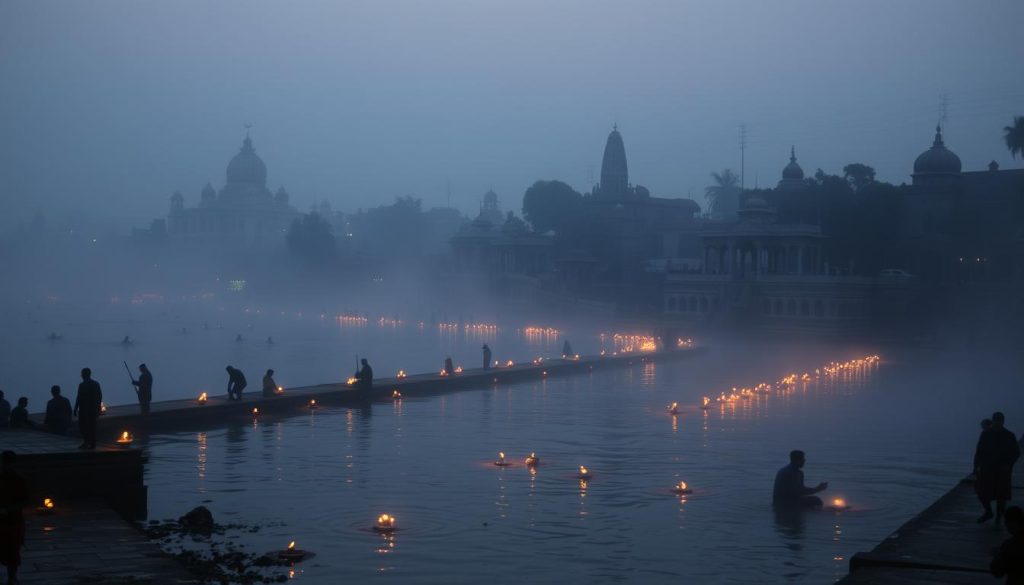
In Haridwar, Hindu priests perform complex rites. During the Ganga Aarti, people gather at Har Ki Pauri. This is the most sacred spot. They offer milk, colors, flowers, and lamps. This creates a beautiful ceremony.
The Ganga Lahari poem is read out loud during the aarti. This shows deep love for the Ganges River. Hidden rituals in Haridwar take place across the city. They honor ancestors and lesser-known gods.
The Daksheshwar Mahadev and Chandi Devi Temples are important. People go there to perform special rituals. They hope to get their wishes granted. Devotees get prasad as a spiritual keepsake.
Haridwar has many secret aspects that show a deeper spirituality. The *hidden rituals in Haridwar* make the city’s faith even richer. They help keep the city’s spiritual practices alive today.
So, Haridwar’s deep religious spirit is kept alive by *hidden rituals*. They are a key part of its culture and faith.
| Location | Significance |
|---|---|
| Ganga Aarti | Major devotional ritual at Har Ki Pauri |
| Ganga Lahari Recitation | Reverence for the Ganges through Sanskrit poetry |
| Chandi Devi Temple | Ancient temple for wish-fulfillment |
| Daksheshwar Mahadev Temple | Temple significant in Sati’s history |
Archaeological Discoveries in Haridwar
Haridwar has many old treasures buried in its soil. These finds tell stories of old times. Artifacts found date back to 5000 BCE, showcasing Haridwar as one of India’s oldest cities.
Ancient Temples
Ancient temples found in Haridwar highlight its spiritual past. The Mansa Devi Temple is one. It was built in the Gupta era. Dedicated to Goddess Mansa, it shows the era’s religious beliefs.
Other small shrines across the city show a rich worship culture.
Historic Artifacts
Many historic artifacts have been found in Haridwar. They help us feel more connected to the past. These include pottery, tools, and religious items. They tell us about the lives of ancient people.
Researchers and historians find these discoveries very valuable. They help us learn more about Haridwar’s past.
Unrevealed Mysteries of Kumbh Mela in Haridwar
The Kumbh Mela happens four times in 12 years at four sacred places. Haridwar’s turn is special because of its history and stories. It draws millions with its unrevealed mysteries in Haridwar.
One secret is its start by Shankara, an 8th-century thinker. He brought smart folks together for big talks. Haridwar is important because people believe immortal nectar fell there. This belief comes from an old story about gods and a magic ocean.
In 2019, Haridwar saw 200 million visitors. On the busiest day, 50 million came. People from every part of Hindu life come to find peace.
In 2010, space scientists took pictures from the sky. They wanted to help plan future events. They say the Kumbh Mela’s timing with the Sun’s cycles affects energy on Earth.
There are groups called naga akhadas. They sometimes compete for the best spots. Big events and ceremonies add to the mystery of Haridwar.
The Kumbh Mela mixes deep faith and mystery. It shows Haridwar’s spirit, rich in tradition and cosmic events.
Haridwar’s Secret Pilgrimage Routes
In Haridwar, away from the crowds, are secret pilgrimage routes. They offer a calm and spiritual journey. These paths are filled with peace, away from the usual noise.
Lesser-known Paths
Haridwar has hidden paths that are magical. They go through hills and forests to sacred spots. A path leads to the Anandamayi Ashram, just 3 kilometers from Haridwar Railway Station.
Another secret path goes to the Rajaji Tiger Reserve, 36.2 kilometers away. Here, pilgrims find peace in nature.
Significance to Devotees
For those on these secret paths, the journey is deeply moving. It takes them to places like Swami Vivekanand Park, close to the station, or Neel Dhara Pakshi Vihar. These are not just walks but life-changing trips.
Walking these hidden paths in Haridwar brings pilgrims closer to the divine. It makes their spiritual trip more special and private.
Surprising Legends and Myths of Haridwar
Haridwar is a sacred place that attracts lots of pilgrims every year. People come not just for its religious importance. They also come for the legends of Haridwar. These legends have been shared for many generations. This ancient city is full of myths. It’s like a magical place where gods and people are part of exciting tales.
One popular Haridwar myths and stories is about King Harshvardhan. He was king from 590 to 647 AD. The story goes that the Ganges River came down to bless the city. This made Haridwar a spiritual heart. Stories like this make the city a special place for those looking for a divine experience.
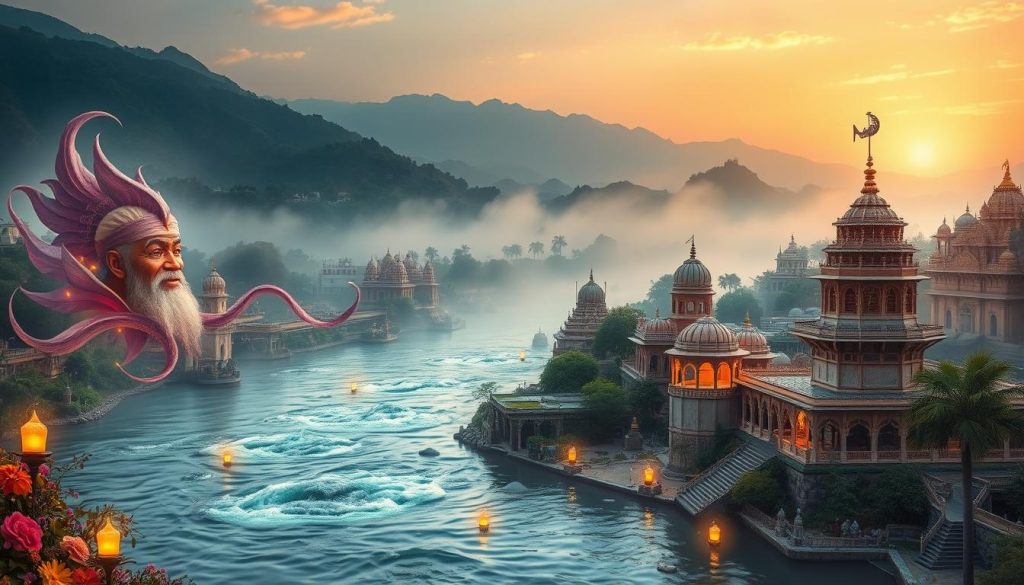
There’s also a tale about a big fight between gods and demons. This story is often told during the Kumbh Mela. The Kumbh Mela happens every twelve years in Haridwar. Millions of people come hoping for spiritual renewal. This big event brings the city’s ancient stories to life.
These myths do more than just make Haridwar special. They connect to its history. The city was very important from 1200 to 1700 BC. It was home to big dynasties like the Mauryans and Kushans. Stories from these times talk about godly help. People believe these helped shape Haridwar’s future.
Haridwar has both mythological and historical stories. People like Timur Lang attacked it in 1336 AD. And Huan Tsang, a Chinese traveler, visited in 629 AD. They’re part of tales that involve meeting gods. These stories make Haridwar’s history very rich and interesting.
Thinking about these legends makes Haridwar even more magical. The divine stories in Haridwar’s stones offer more than comfort. They show a world where gods and people meet. This makes the legends of Haridwar always fascinating.
| Legend | Story | Historical Context |
|---|---|---|
| King Harshvardhan’s Blessing | The Ganges descends to bless Haridwar | Ruler from 590 to 647 AD |
| Celestial Battle | Gods vs. Demons during Kumbh Mela | Held every twelve years |
| Timur Lang’s Rule | Divine encounters during the invasion | Invasion around 1336 AD |
| Huan Tsang’s Visit | Experiences divine interventions | Visited in 629 AD |
Ecological Wonders Surrounding Haridwar
Haridwar’s beauty is not just about spirituality. It’s also in the nature that surrounds it. The area is full of natural wonders. These offer a peaceful escape for those who love nature.
Flora and Fauna
Neel Dhara Pakshi Vihar welcomes over a hundred migrant bird species. This makes Haridwar a paradise for bird lovers. The sanctuary is by the Ganges. It’s a perfect spot for watching birds.
Also, Rajaji National Park is close by. It’s home to many endangered animals. This makes the park a key spot for Haridwar’s natural beauty.
The Rajaji Tourist Caves are another wonder. They stretch for about 4km underground. Here, you’ll find many unique species. These caves add to Haridwar’s rich natural world.
Natural Beauty
Haridwar is known for its holy sites. But it’s also filled with natural beauty. Views from Chandi Devi Temple are breathtaking. The temple looks over the Ganges river.
At Chandeshwar Temple, you can see ancient stone carvings. They are from the 1st millennium. This adds historic beauty to the natural landscapes.
The Anandmayi Maa Ashram is in Haridwar’s green lands. It’s a place full of joy for many, especially the elderly. Swami Satyamitranand Giriji’s ashram is also here. It’s known for its Vedic Yagnas. They’re done for “universal welfare.” This shows the mix of nature and spirituality.
Haridwar’s natural beauty is in its rich biodiversity and stunning landscapes:
- Chandi Devi Temple: It has thousands of red and gold ribbons. Each one is a prayer of hope.
- Rajaji National Park: Home to endangered species and vast underground caves.
- Neel Dhara Pakshi Vihar: Over a hundred types of migrant birds live here.
- Chandeshwar Temple: You’ll find ancient stone carvings from the 1st millennium.
| Attraction | Unique Feature |
|---|---|
| Har Ki Pauri Ghat | Daily river baths attracting 5,000 to 10,000 people |
| Kumbh Mela | Gathering of millions every 12 years |
| Anandmayi Maa Ashram | Evokes joyful memories among elderly devotees |
| Swami Satyamitranand Giriji’s Ashram | Vedic Yagnas for “universal welfare” |
Thus, Haridwar’s nature and beauty offer a peaceful place for many. It’s home to different plants and animals. And it gives people a chance to enjoy the beauty of nature.
New Discoveries About Haridwar’s Spiritual Heritage
The search in Haridwar brings new insights about its holy past. These discoveries help us know more about its spiritual side. We see parts of its soul we didn’t know before.
We have found new things about Haridwar’s rituals like the Ganga Aarti. It is held at Kankhal Haridwar every night. It uses prayers, lamps, chants, and incense to help people grow spiritually. Kankhal opens the door to liberation from life and death.
Recent studies show the importance of temples in Kankhal. These include Mansa Devi temple, Chandi Devi temple, and Har Ki Pauri. They help cleanse the soul and bring enlightenment. The old Maya Devi Temple, built in the 11th century, also adds to Haridwar’s spirit.
New facts about Bhimgoda Barrage and Anandamayi Ashram add to Haridwar’s spiritual story. They show Haridwar’s mix of history and lasting spiritual beliefs. This makes Haridwar a timeless place for pilgrims.
Below, a table summarizing notable sites and their contributions to Haridwar’s spiritual legacy:
| Site | Significance |
|---|---|
| Har Ki Pauri | Religious ceremony of Ganga Aarti, pivotal for generations. |
| Chandi Devi Temple | Panoramic views, popular for adventure and spiritual balance. |
| Rajaji National Park | Rich biodiversity, nature driven experiences complement spiritual visits. |
| Bhimgoda Tank | Serene picnic spot, promoting familial bonds through spirituality. |
| Maya Devi Temple | 11th-century temple, spiritual enlightenment, and historic significance. |
| Jairam Ashram | Tranquility, yoga, meditation, and family spiritual activities. |
As Haridwar reveals more discoveries, they offer new views on its spiritual legacy. This enriches its ancient rituals and the way we see its deep religious sense.
Intriguing Haridwar Facts That Tourist Guides Won’t Tell You
Haridwar is more than famous temples and the sacred Ganges. Many cool facts often go unnoticed. For example, the Damru Arti at Daksha Mahadev Temple is a unique experience. Unlike Har Ki Pauri, fewer people, sometimes less than 50, attend it. It gives a closer look at Haridwar’s spiritual side.
Hidden Stories
Haridwar has lots of stories and legends that many don’t hear about. One hidden gem is the 13th-century Sufi Shrine Piran Kaliyar. It draws Islamic delegates and visitors during its annual Urs fair. Also, there’s the world’s largest food park at Patanjali Yogpeeth. It’s a food lover’s dream that’s often missed.
Offbeat Experiences
In Haridwar, you can find really unique things to do. For example, Rajaji National Park offers jeep safaris to see wild elephants and tigers. Then, there’s fish feeding at Neel Dhara. Fish swarm around for food, which is pretty cool to watch. Also, check out Khanna Sweet House. They have over 30 kinds of laddus, showing Haridwar’s tasty traditions. These hidden spots make visiting Haridwar truly unforgettable.
FAQ
What are some hidden facts about Haridwar that not many people know?
Haridwar is known for more than its holy status. There are hidden pilgrimage routes. Plus, ancient civilizations have left a rich history along the Ganges.
Why is Haridwar referred to as the Sacred City?
Haridwar is the gateway to the divine. It is where the Ganges exits the Himalayas. This makes it a major spot for millions of devotees.
What is the importance of the Ganges River in Haridwar’s culture?
The Ganges is the city’s lifeblood. Its waters are seen as divine. This shapes the city’s culture, practices, and traditions.
Are there any hidden rituals and ceremonies unique to Haridwar?
Yes, Haridwar has hidden rites and ceremonies. They include priestly and ancestral traditions. These reflect its deep spiritual landscape.
What has been discovered through archaeological findings in Haridwar?
Archaeology has revealed Haridwar’s ancient temples and relics. These findings show the city’s rich religious and historical importance.
What are some lesser-known paths for pilgrimage within Haridwar?
Beyond popular routes, Haridwar has hidden paths. These lead to secluded sacred spots. They offer a distinct spiritual journey.
What are some hidden mysteries of the Kumbh Mela in Haridwar?
The Kumbh Mela is surrounded by mysteries. Its ancient beginnings, mythological links, and vastness are partly unknown. These aspects add mystery to the event.
Are there any surprising legends and myths associated with Haridwar?
Haridwar’s lore includes celestial battles and divine acts. These stories deepen the city’s spiritual allure. They offer captivating tales.
What is unique about the flora and fauna in Haridwar?
Haridwar’s biodiversity is unique along the Ganges. It is a haven for many plants and animals. This highlights its ecological beauty.
What new discoveries have been made about Haridwar’s spiritual heritage?
New findings shine light on Haridwar’s sacred history. They reveal ancient rituals and long-standing traditions. This uncovers new layers of the city’s spirit.
What are some intriguing facts about Haridwar that tourist guides don’t usually mention?
Tourist guides often miss unique stories. These include uncommon anecdotes, incidents, and ceremonial practices. They add depth to Haridwar’s mystique.


